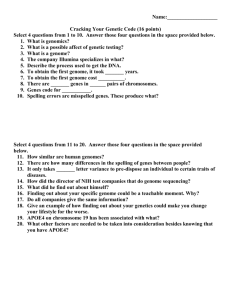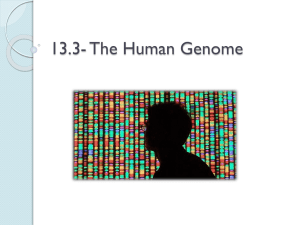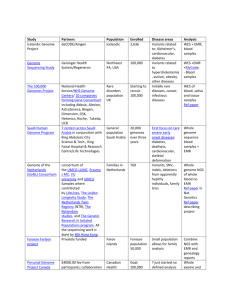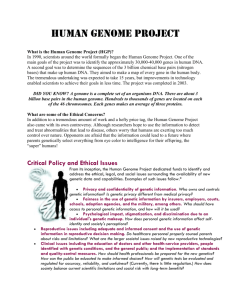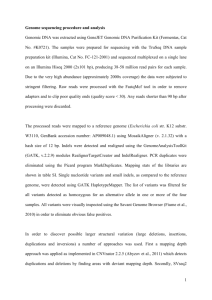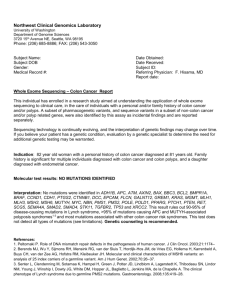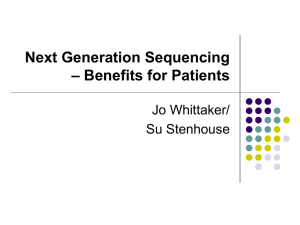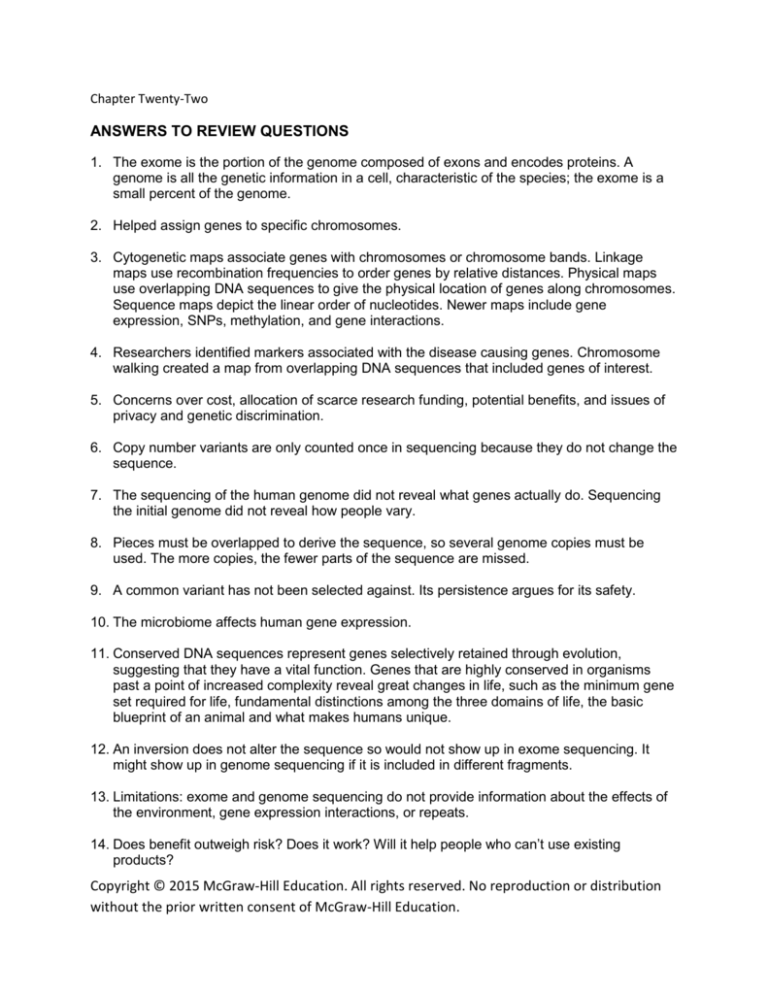
Chapter Twenty-Two
ANSWERS TO REVIEW QUESTIONS
1. The exome is the portion of the genome composed of exons and encodes proteins. A
genome is all the genetic information in a cell, characteristic of the species; the exome is a
small percent of the genome.
2. Helped assign genes to specific chromosomes.
3. Cytogenetic maps associate genes with chromosomes or chromosome bands. Linkage
maps use recombination frequencies to order genes by relative distances. Physical maps
use overlapping DNA sequences to give the physical location of genes along chromosomes.
Sequence maps depict the linear order of nucleotides. Newer maps include gene
expression, SNPs, methylation, and gene interactions.
4. Researchers identified markers associated with the disease causing genes. Chromosome
walking created a map from overlapping DNA sequences that included genes of interest.
5. Concerns over cost, allocation of scarce research funding, potential benefits, and issues of
privacy and genetic discrimination.
6. Copy number variants are only counted once in sequencing because they do not change the
sequence.
7. The sequencing of the human genome did not reveal what genes actually do. Sequencing
the initial genome did not reveal how people vary.
8. Pieces must be overlapped to derive the sequence, so several genome copies must be
used. The more copies, the fewer parts of the sequence are missed.
9. A common variant has not been selected against. Its persistence argues for its safety.
10. The microbiome affects human gene expression.
11. Conserved DNA sequences represent genes selectively retained through evolution,
suggesting that they have a vital function. Genes that are highly conserved in organisms
past a point of increased complexity reveal great changes in life, such as the minimum gene
set required for life, fundamental distinctions among the three domains of life, the basic
blueprint of an animal and what makes humans unique.
12. An inversion does not alter the sequence so would not show up in exome sequencing. It
might show up in genome sequencing if it is included in different fragments.
13. Limitations: exome and genome sequencing do not provide information about the effects of
the environment, gene expression interactions, or repeats.
14. Does benefit outweigh risk? Does it work? Will it help people who can’t use existing
products?
Copyright © 2015 McGraw-Hill Education. All rights reserved. No reproduction or distribution
without the prior written consent of McGraw-Hill Education.
15. Types of information learned from knowing genome sequences: what recessive genes are
carried; mutations that will manifest in the future; which drugs are likely to be effective with
minimal side effects.
ANSWERS TO APPLIED QUESTIONS
1. Genetic and genomic information can help a health care provider to diagnose disease. For
example, a person may have anemia for many reasons, inherited and acquired (such as
from a poor diet). Knowing the genetic cause can indicate the most appropriate treatment,
but the symptoms of anemia might have been what led a person to contact a health care
provider, and be tested to detect the anemia. Then genetic testing could have provided
much more specific information. The other way around, diagnosing based on a genetic or
genomic test, can lead to a false positive due to incomplete penetrance. Genetic tests are
less helpful and precise for multifactorial conditions because many causative factors each
contribute to a different degree.
2. A standard diagnostic test is less precise than a DNA-based test. A DNA test provides
information on the mechanism of the illness.
3. An advantage is cost savings. Disadvantages are missing diagnoses and stereotyping
people, which could be construed as discrimination.
4. Opinion
5. Genome sequencing can reveal de novo cases—genetic disease that arises from
spontaneous mutation and therefore is not in the family.
6. A child born with symptoms that no one else in the family has, and that does not match a
known syndrome.
ANSWERS TO WEB ACTIVITIES
1. The first phase of eMERGE associated variants (such as SNPs) to clinical measurements
and other phenotypes in many people. The second phase is applying that information to
refine genetic risk assessment, prevention, diagnosis, and choice of treatment. Issues such
as privacy and accessibility are also being examined.
2. Individual hu43860C at the Personal Genome Project is a 246-pound white male who
stands 6 feet, 5 inches tall. He has chest pain, high triglycerides, narcolepsy, and squamous
cell carcinoma. He takes Flonase and a statin drug. His genome sequence indicates that he
is a heterozygote for a form of Charcot-Marie-Tooth disease, alpha-1-anti-trypsin deficiency
(inherited emphysema), Bardet-Biedl syndrome, and right ventricular cardiomyopathy. He
will likely develop age-related macular degeneration. If he were female, he would be at
slightly elevated risk of having a child with Down syndrome.
Copyright © 2015 McGraw-Hill Education. All rights reserved. No reproduction or distribution
without the prior written consent of McGraw-Hill Education.
3. Genome analysis of thyroid tumors from 500 patients revealed gene variants associated
with more serious disease that is likely to spread.
4. Affordability of exome and genome sequencing.
5. Identification of gene variants in people with mitochondrial disease, autism, epilepsy,
intellectual disability, metabolic conditions to determine which drugs are likely to work and
offer suggestions about diet.
ANSWERS TO CASE STUDIES AND RESEARCH RESULTS
1. (a) AAGCTAAT and TAGCTACT (b) 4 and 8 (c) 1 (d) 1 due to variability (e) Fish #3
2. Such an experiment might be considered unethical and would be difficult to control, but
compare a group of individuals who base their lifestyle choices on knowledge of their
genomes (theirs or their health care providers) to a matched group who do not have
genome information, and compare their long-term health.
3. a. phenotype b. a heterozygote for either of the mutations that his parents have, or wildtype c. 1 in 4 d. dominant e. the mother is a manifesting heterozygote
Copyright © 2015 McGraw-Hill Education. All rights reserved. No reproduction or distribution
without the prior written consent of McGraw-Hill Education.

